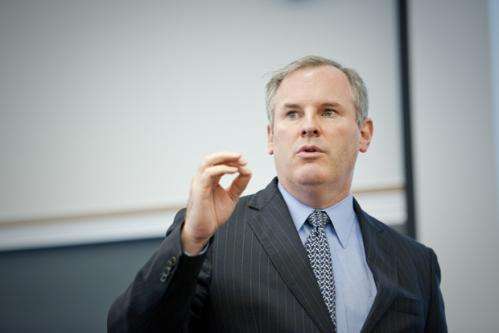Taking lessons from Hurricane Sandy

Hurricane Sandy killed dozens and left millions in the dark. Stephen Flynn, the founding co-director of Northeastern's George J. Kostas Research Institute for Homeland Security, and an expert in community resilience and critical infrastructure protection, suggests that the key to withstanding such fierce natural disasters lies in taking care of our nation's critical infrastructure.
Hurricane Sandy has killed at least 59 people, including 22 in New York City. Are deaths caused by natural disasters inevitable? If not, what more could be done to spare the lives of those living in their path?
We will never likely reach a point where major natural disasters won't involve the tragic loss of life—disasters have too many unpredictable elements. But we should always feel obligated to honor the lives so tragically lost by taking the time to learn the lessons of what went wrong and why. Then we should commit ourselves to becoming better prepared and more resilient when disasters next strike. There is much that we can be doing as individuals, companies, communities, regions and as a nation to better anticipate disasters.
There are also proven cost-effective measures that we can undertake in advance that will mitigate the harm disasters cause and bolster the speed at which we recover. One thing we must stop doing is neglecting our nation's critical infrastructure such as transportation systems, the electric grid, fresh water and waste-water treatment systems that underpin our daily lives. When these systems become brittle because of age and overuse, they will fail badly as they have in New York City. Sadly, it seems to take a major disaster to generate the political will to tackle the things that common sense should have told us would be best done in advance.
In speaking to those affected by Hurricane Sandy, President Obama said, "We are standing behind you, and we are going to do everything we can to help you get back on your feet." Mitt Romney, on the other hand, sponsored a canned food drive in the swing state of Ohio and has argued that disaster relief should be decentralized. In your opinion, what roles should the federal and local governments play in the recovery effort of a region-wide natural disaster?
Under our federalism form of government, disaster response and relief has always been decentralized—mayors and governors are in charge of incidents that happen in their jurisdictions. The federal government's role has historically been to provide assistance when local and state capabilities are overwhelmed. It has played this role in every major disaster dating back to the San Francisco Earthquake of 1906 when more than 4,000 troops from the U.S. Army's Pacific Division were mobilized to provide emergency relief including constructing temporary housing for 20,000 survivors. So the real question the presidential candidates should be debating is: how proactive of a role does the federal government play?
My view is that the role of the federal government must grow as the scale of disasters has grown. Disasters like Hurricane Sandy increasingly involve multiple states. To coordinate a rapid and effective response and recovery requires preplanning. And part of any thoughtful preplanning should be an appropriate discussion about what states and localities should be doing in advance to mitigate the risk that likely disasters will not cause needless loss of life and property. Relegating the federal government to the kind of passive response and recover role that the George W. Bush administration had assigned to FEMA prior to 2005, practically guarantees we will witness future replays of the kind of inept response we saw after Hurricane Katrina.
According to the Department of Energy, Hurricane Sandy left more than 8 million people without lights, heat, TV or Internet, underscoring the vulnerability of the nation's power grid. How great is the possibility of a terrorist attack on the U.S. electric grid—and how damaging could it be?
What Hurricane Sandy has helped to highlight is that not only can disasters lead to short-term electrical power outages, but they can also damage critical components of the power grid that require considerable time to replace. Converting the voltage generated by power plants into the electricity we use in our homes is done at substations that house sophisticated equipment such as transformers. This equipment is costly and time consuming to replace and there are not many spares. So when salt-water flooding damages these substations, it can take several weeks to conduct repairs.
When these are isolated events, there are typically other ways for utility companies to restore power to most users. It would be very worrisome, however, if multiple systems were damaged as a result of terrorist cyber-attacks that exploit known vulnerabilities in the industrial control systems that are essential to operating the electric grid. The consequence of such an attack would be to cause the kind of outages that left so many in the dark after Hurricane Sandy—but those outages would last several months.
Provided by Northeastern University



















